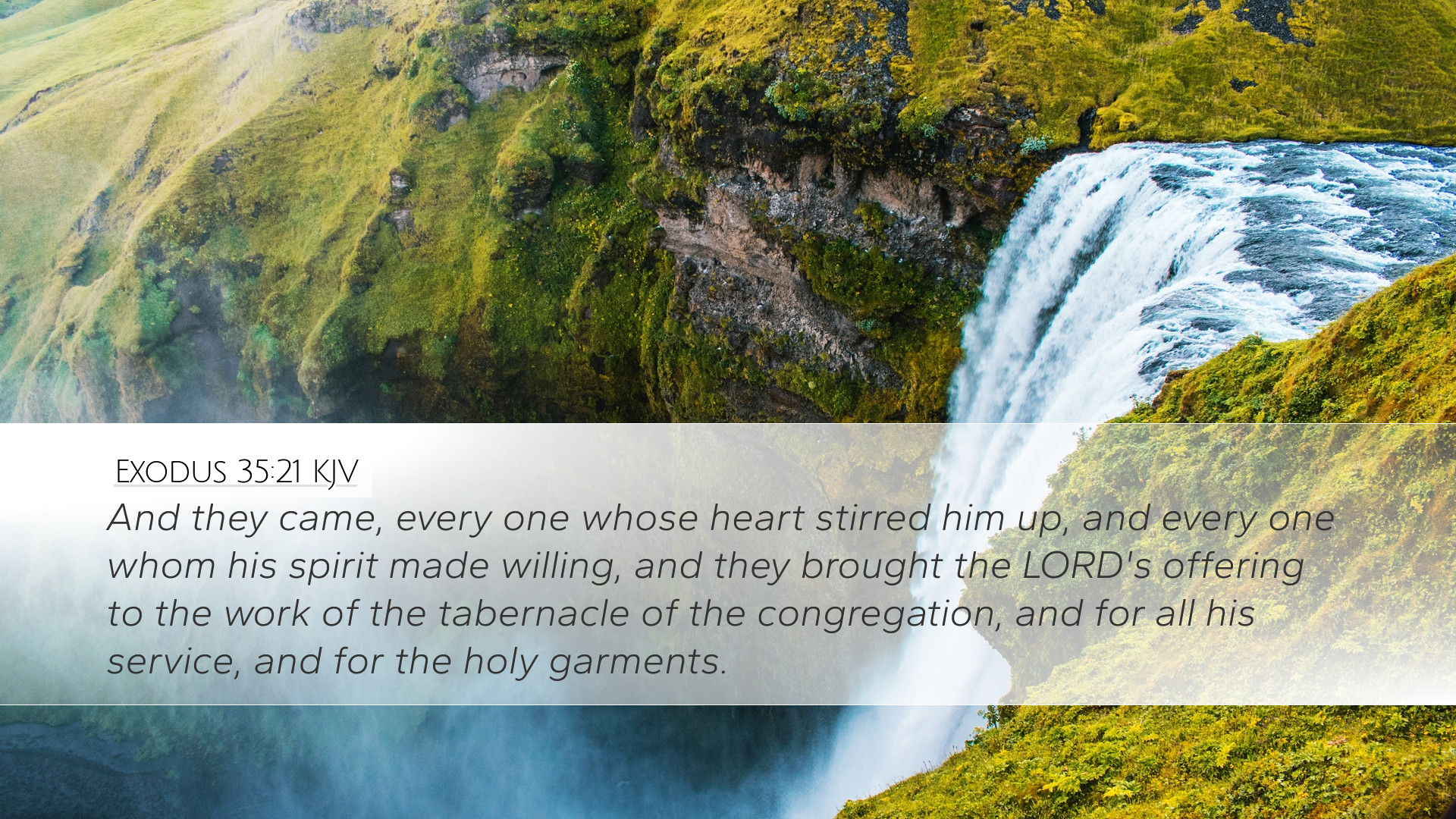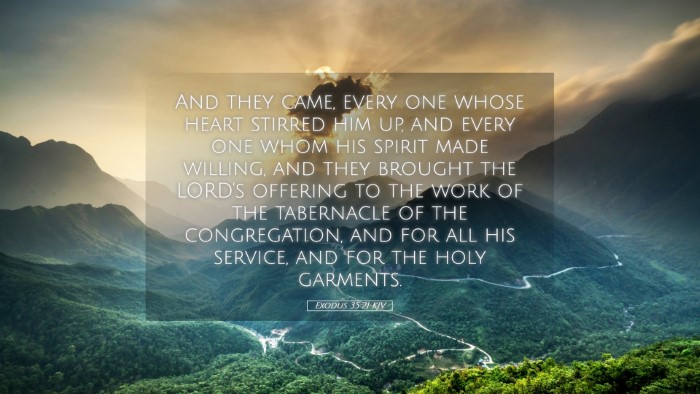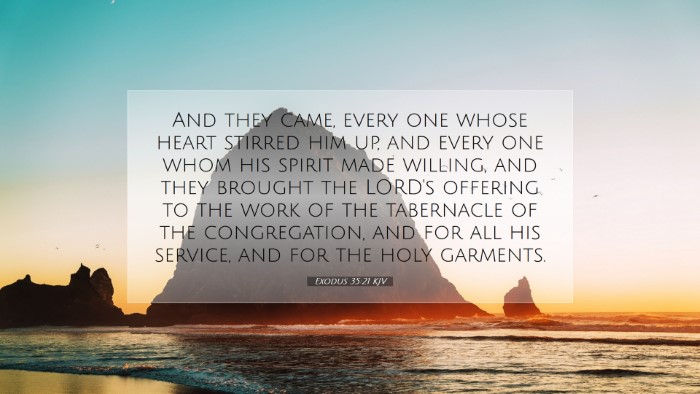Exodus 35:21 - Summary and Commentary
Exodus 35:21 states:
"And they came, every one whose heart stirred him up, and every one whom his spirit made willing, and they brought the Lord's offering to the work of the tabernacle of the congregation, and for all his service, and for the holy garments."
Introduction
This profound verse captures a moment of voluntary service and devotion among the Israelites as they contribute to the construction of the Tabernacle. This commentary seeks to provide insights from respected public domain commentators, including Matthew Henry, Albert Barnes, and Adam Clarke, to elucidate the significance of this passage.
Contextual Background
Exodus 35 follows God's previous detailed instructions for the construction of the Tabernacle, a central place of worship for the Israelites during their journey in the wilderness. This chapter emphasizes the cooperative spirit and willingness of the people to engage in what God has commanded them to accomplish.
The “Heart Stirred” and “Willing Spirit” - A Divine Call
Matthew Henry notes that the phrase "every one whose heart stirred him up" indicates a divine influence over the hearts of the people. This stirring is not merely emotional but signifies a profound internal motivation that comes from God, calling them to action.
Albert Barnes elaborates on the theme of willing offerings, suggesting that true service to God begins with a heart willing to respond to His call. In essence, the people's response is a reflection of their relationship with the Creator, indicating the necessity of a willing heart for God's work.
The Nature of Offerings
The offering brought forth by the Israelites was not a obligatory tax but rather a heartfelt contribution stemming from gratitude, love, and reverence for God’s commandments. Adam Clarke stresses that this act of giving was intrinsically tied to their faith, emphasizing that their offerings were significant for both the building of the Tabernacle and the spirit of community among the Israelites.
Types of Offerings Made
The offerings mentioned in the verse included various materials necessary for the construction and service of the Tabernacle. These offerings may be broken down into:
- Gold, Silver, and Bronze: Precious metals used for the aesthetic and structural elements.
- Blue, Purple, and Scarlet Yarn: Colors representing royalty, the divine, and the sumptuous design of the garments for the priests.
- Fine Linen and Goat Hair: Materials for clothing and coverings that symbolize purity and humility.
- Animal Skins and Acacia Wood: Functional materials essential for structure and durability.
The Role of Community in Service
The coming together of individuals for a collective purpose is a prominent theme in this verse. Matthew Henry discusses how their unity and willingness serve as a model for today's church, where members should offer their unique gifts to advance the kingdom of God.
Albert Barnes expands on this concept, suggesting that community involvement fosters a spirit of cooperation. It is vital for church leaders to encourage an environment where congregants feel both valued and empowered to contribute their resources and talents.
Theological Implications
The spiritual act of giving highlighted in this passage resonates significantly within the theological understanding of stewardship. Adam Clarke asserts that God desires not just the gift itself but rather the spirit with which the gift is given. Thus, this passage can serve as a foundation for teachings on generosity, where the motivation and disposition of the heart take precedence over mere material contributions.
Willingness versus Obligation
It is compelling to note that while the Israelites brought forth their offerings voluntarily, it reflects a profound understanding of willing service versus obligatory sacrifice, a distinction vital for church teachings today. Matthew Henry stresses that a heart motivated by love is far more beneficial than a coerced contribution.
Practical Applications
For pastors and church leaders, this verse invites reflection on how they can cultivate willing participation within their communities. The role of encouragement, teaching, and shared vision is essential.
Albert Barnes suggests creating an atmosphere where members feel inspired to offer their best to the Lord. This can be achieved through prayer, fellowship, and teaching the Biblical principles of generosity.
Encouraging Generosity in the Church
- Teach About Stewardship: Empower congregants by educating them on the Biblical model of giving.
- Share Testimonies: Encourage members to share their experiences of giving and how it has enriched their faith journey.
- Foster Community: Create events where offerings can support community needs, reinforcing the communal aspect of giving.
Conclusion
Exodus 35:21 provides a powerful illustration of the essence of giving in service to God—rooted in the heart, driven by spiritual willingness, and resulting in communal engagement. As we reflect on this verse, we are reminded that God values our hearts far more than our material contributions, and that true service arises from a spirit stirred by His love and grace.
In stewardship, we must aim to engage our communities in a way that is both glorifying to God and transformative for individuals who respond to the call of service.


